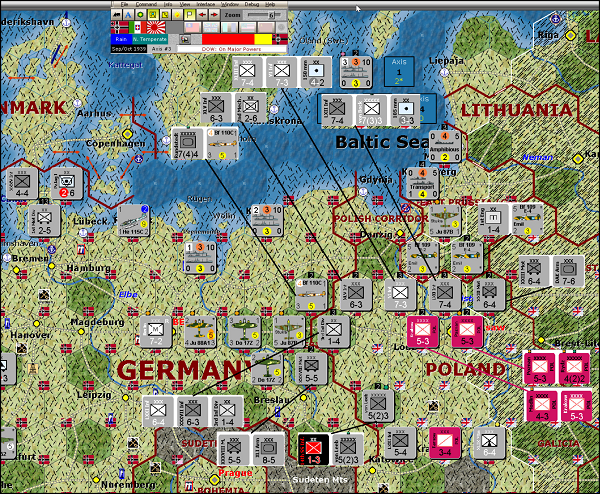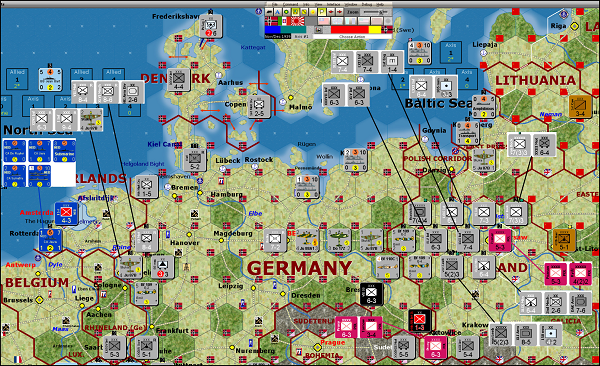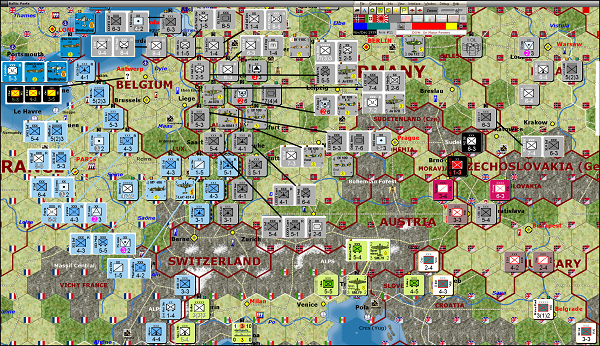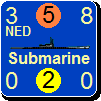Daniele
Posts: 1812
Joined: 2/7/2015
Status: offline

|
Chapter 2: German Conquests 1939
A typical sequence of events in MWIF is for Germany to conquer Poland and Denmark in the first turn (Sep/Oct 1939). Then, pretty much despite the weather, conquer The Netherlands in the second turn (Nov/Dec 1939). The conquest of Belgium usually waits until the German paratroop unit arrives in Mar/Apr 1940, turn #4. The impulse following Germany’s DOW on Belgium, France often gets the opportunity to occupy four hexes in Belgium on the French border. Although 3 of those 4 Belgian border hexes are clear terrain and vulnerable to blitz attacks by bombers and armored units, they provide another layer of hexes between the Germans and Paris. Getting through them takes 2 or 3 Axis impulses with good die rolls.
This game did not follow that path.
Poland
The first screenshot (Figure 2-1) shows the position with Germany deciding about declarations of war at the beginning of the third impulse of the first turn. G’s setup was a common solid defensive position for the Polish land units while the air units were placed out of harm’s way in far northeastern Poland. The air units rebased to a neutral minor country during the second (Allied) impulse, thereby becoming ‘interned’. That permanently removed them from the game, but gave the Commonwealth two additional pilot units arriving in Great Britain at the start of the second turn.

G placed four Polish corps in Lodz and Warsaw. Because those cities contain factories, Poland is only conquered if Germany captures both of them. Spreading out the other 3 corps, G placed a single corps north of Lodz/Warsaw, one in Poznan (two hexes west of Lodz), and one in Krakow. The last corps was the 3-4 cavalry unit, which in the screenshot hasn’t moved from Krakow. The sole divisional infantry unit he placed in the forest hex currently occupied by von Leeb.
To attack Lodz and Warsaw I prefer to have at least 3 adjacent hexes. G’s setup prevented that. So, during the first impulse of the game, I took out the corps north of the cities, the corps in Poznan, and the division. Those attacks were certain victories and disorganized no German units. Prior to those land moves and attacks, the German air force flew 4 ground strikes, 2 each on Lodz and Warsaw. 3 of the 4 Polish units in those cities were disorganized (as indicated by the small orange circles above the units). That also accounts for the 4 disorganized German air units visible in the screenshot. MWIF uses small colored circles around the units as status indicators. The only other status indicators shown in this screenshot are the dark green ones above the HQ units, which indicate they are secondary supply sources.
While the first two impulses went about as expected, the bad weather roll at the start of the third impulse was painful for Germany. The splatter of short black lines in hexes indicates Rain over most of the map. The more numerous parallel black lines in the east indicate Storm. In fine weather most hexes cost 1 movement point. That cost is doubled in Rain and Storm. Note the German units just south of Denmark. Crossing a straits hexside (shown with red connecting arrows) costs an extra movement point for land units. If Germany declares war on Denmark, Denmark is always devoid of land units. The only land unit Denmark has is a reserve unit, which doesn’t arrive until the turn after the Axis declares war on it. However, Germany wants to move immediately into Copenhagen and the two Danish minor ports. Failing to do so would give the British the opportunity to reinforce those hexes, making the conquest of Denmark much more difficult. The German units positioned to conquer Denmark have movement allowances of 4, 5, and 6 respectively. Only two of them are needed to take out the ports and city. But the weather has to be Fine for them to reach their destinations. Hence, Germany did not declare war on Denmark in the third impulse.
Additionally, Rain makes movement for the German units in Poland more difficult. Even worst, all the land attacks receive a -2 DRM (die roll modifier). Also aggravating, the air units have their ground strike and ground support factors halved in Rain. I decided on attacking just Lodz from 3 and a half hexes, with very good odds. Sadly, a bad attack die roll only destroyed one Polish unit in Lodz, leaving the hex occupied by the other unit and remaining under Allied control. The German HQs were able to reorganize all the German units disorganized by the failed attack.
Mercifully, after the Allies moved in impulse #5, the weather turned Fine again (impulse #7). Still, attacking both Lodz and Warsaw wasn’t really feasible. Those attacks could have been executed, but a failure of the attack on Warsaw would have made taking it out in the first turn impossible, since the German units would have been disorganized. Instead I chose to just kill off the Polish unit in Lodz and prepare for an attack on Warsaw from 6 hexes in the following impulse. In the meantime, the Fine weather meant that Germany declared war on Denmark and captured both minor ports and Copenhagen as planned.
The Netherlands
Alas, G’s die roll ended the first turn after his impulse (#8) - a 20% chance. So Poland survived through to Nov/Dec 1939. Subsequently, a Polish reserve reinforcement (6-3) was placed in Krakowice (Figure 2-2). That was possible because the Polish cavalry corps had scurried to that hex during G’s final land movement phase of the first turn. G had also had the USSR claim Eastern Poland and the Baltic States (Lithuania, Latvia, and Estonia) as shown in the screenshot. The flags in the hexes indicate which are held by Germany, the USSR, and the Commonwealth. No flag means the country controlling the hex is neutral (e.g., Belgium).
Now we pick up the action at the start of the second turn (Nov/Dec 1939). Since the Axis won the initiative (yaa!), chose to move first (obviously), and then the weather was Fine (yaa!), Germany declared war on The Netherlands. The German units lined up on the border with the Netherlands are mostly the reserve units that Germany placed on the map when France and the Commonwealth declared war on Germany at the start of the second impulse of the first turn. Their placement was planned for just this situation.
Happily for the Axis, the Commonwealth has their naval transports in the Mediterranean and unable to reach the North Sea. What this means is that it will be impossible for the Allies to send a land unit to help The Netherlands. Usually, the Commonwealth keeps at least one transport available specifically for that task. Then, even if Germany captures Amsterdam, the Commonwealth can land one or more units in Rotterdam. Holding Rotterdam is very helpful for protecting Belgium. It is also a very strong defensive hex with rivers on the two hexsides through which the Germans would have to attack.
In the game, Germany easily captured Amsterdam then occupied Rotterdam in the next Axis impulse.
Note that Germany conquered Denmark last turn and all the Danish hexes are now controlled by Germany. In Poland, Germany will attack and capture Warsaw - finally. In southern Poland, the 9 combat factors in Krakowice are a bit too much to take on right now. G used those two units to annoy me for the rest of the turn. But the main focus of the German army turns to the Lowland countries. That means that most of the German units, both land and air, headed west.

Belgium
After the bad luck in the first turn, the Axis was more than compensated by good luck in the second turn. Figure 2-3 shows the position at the German DOW phase of the 11th impulse of the second turn. The weather is Fine. To reach this state, the Axis had to have several more good land movement weather rolls: Fine or Snow. Taking advantage of that, the mass of the German army, accompanied by the air force, has moved from Poland to the Belgian border. Then the weather turned Fine for the 11th impulse, letting Germany declare war on Belgium with certainty of success.

As mentioned earlier, a German paratroop would be very helpful here. But it doesn’t arrive for two more turns. Given the sunny skies and eager troops in their jump off positions, taking out Belgium this early in the game couldn’t be resisted. G has three Belgian land units to place anywhere in Belgium. He chose one of the best setups for them: the 3-5 cavalry in Liege and the other two corps in Antwerp. Belgian and French zones of control into adjacent hexes prevented the Germans from reaching Brussels. This is where the paratroop unit would have been a big help.
Regardless, the benefit of the rivers for defense evaporates during the surprise impulse following a declaration of war. So Germany has two attack hexes on Antwerp plus 4 on Liege. The air unit tactical factors are doubled during the surprise impulse, and Belgium’s allies are unable to fly air missions to support them. A good land combat die roll on Antwerp wiped out the Belgian defenders. That was followed by the Axis ending the turn (50% chance) and going first the next turn (Jan/Feb 1940). Moving first enabled the Germans to occupy all of Belgium. It fell at the end of the third turn. This achieved all that the Axis could have hoped for in Jan/Feb 1940. The rest of the third turn was boring. The weather was bad with the impulse number advancing by 2 or 3, making the turn quite short.
Yugoslavia
If you look over to the southeast on the screenshot, you will see that both Hungary and Yugoslavia have entered the war. Italy, although not at war with France or the Commonwealth, is at war with Yugoslavia. All of this came about because of the two annoying Polish units that survived the first turn. In order to protect Vienna and Bratislava, I had to align Hungary to Germany. But that wasn’t permitted unless Germany was at war with Yugoslavia. While trying to prevent the Poles (and the Yugoslavians) from taking out German cities, and concurrently preventing dangerous Allied counterattacks, the Axis forces are poorly positioned in Austria and Czechoslovakia. Poland will be conquered at the end of the turn, which will remove the last two Polish units from the map. Until then, they needed careful monitoring. MWIF is never easy - even with mostly good die rolls.
Conclusion
The Germans were able to conquer Denmark on schedule in Sep/Oct 1939. But the conquest of Poland was delayed until Nov/Dec 1939. That persuaded Germany (and Italy) to declare war on Yugoslavia and then align Hungary. All of which was helpful for the Allied cause. In recompense, the gods of chance had the second turn run long with good weather, letting the Germans conquer both The Netherlands and Belgium in 1939. As a coup de gras for the Lowlands, the Axis ended the second turn at the best possible time and moved first in the third turn (Jan/Feb 1940), thereby occupying all of Belgium.
< Message edited by Daniele -- 4/10/2019 8:02:14 AM >
|
 Printable Version
Printable Version









 New Messages
New Messages No New Messages
No New Messages Hot Topic w/ New Messages
Hot Topic w/ New Messages Hot Topic w/o New Messages
Hot Topic w/o New Messages Locked w/ New Messages
Locked w/ New Messages Locked w/o New Messages
Locked w/o New Messages Post New Thread
Post New Thread